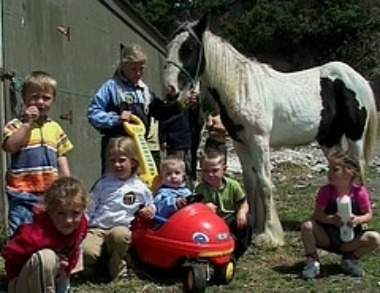They’ve had many names: tinkers, travelers, gypsies, Lucht Siuil (“the walking people” in Irish), and Pavee, in their own tongue. There are only about 36,000 of them in Ireland and they’ve traded their distinctive horse-drawn carts for gleaming trailers and, increasingly, houses, just as they’ve given up tinsmithing and seasonal farm labor as 21st life encroaches on their centuries-old itinerant culture.
On Sunday, the University of Pennsylvania Museum of Archaeology and Anthropology will present the short film, “Settling Down,” a look at a small group of Irish travelers in Cork and how their identity and culture has been transformed as a result of bigger changes in Ireland.
Joseph Lennon, director of the Irish Studies Program at Villanova University, will be speaking about the film and the uncertain future facing the travelers. We spoke to Lennon this week.
What’s the film about?
It focuses on pretty localized incidents in Cork and right outside Cork City where the city corporation is trying to negotiate with a group of travelers about keeping some of their camp sites open and creating more open space and fields for their horses. One of the travelers asks many, many times, “Where can we go?” It seems like the big question in today’s Ireland. How are travelers going to find any place they can go? It’s a problem that endures. It’s about land. It’s about prejudice. There’s still a lot of fear of this pretty insulated community and what they do and what they’re about. As much as we know about them and studied them and talked to them, they’re a closed community with their own language, and people are fascinated by that.
Travelers are ethnic Irish. Why is there so much prejudice against them?
It’s half romanticism and half fear. Historically there has been this projection of the settled population, of us, onto this romantic itinerant group that seems to buck the rules of modernity. The truth is, for every incident of traveler theft there are hundreds of thousands of incidents of no theft, but things get magnified both in the media and our cultural imagination. You have to remember too that the population of Ireland had struggled to own their own land for hundreds of years after it was confiscated by the British. It was one of the goals of Irish immigrants to the United States and in Ireland to get land. They have a great passion for that; it’s seen as the most prized possession. For people who never aspired to that, there was a sense that they were the losers in life. Michael Hayes, a scholar in this area, calls it the dropout theory: They couldn’t make it in society so they dropped out. And as the documentary points out, the travelers were left out of Ireland’s economic boom times. They’re considered working class people who don’t have the same ambitions as settled people. They’re not seen as a different ethnic group or lifestyle, but a group that should assimilate and most travelers don’t want to assimilate. Their lifestyle and culture is to be on the road. Ireland has difficulty with multiculturalism. Only in the last 15 has Ireland had any immigrants. The immigrants who are coming to Ireland have brought awareness of the need for advocacy for the travelers.
What are their origins? I’ve read that they’re descended from ancient traveling poets or that they’re descendants of people turned out of their homes during the famine.
It’s difficult to say. There’s no absolute origin story for the travelers. Going back to the mid-17th century, there were these traveling bards or the Filid, people who would travel between districts or kingships as storytellers, bringing news, telling stories, acting as historians, doing genealogies, things that were very meaningful in those societies. It may be that the travelers picked up on that tradition, coopted it if you will, and picked up some of the stories and the oral culture. They are certainly more practiced in orality than, say, people who watch TV all the time, so there may be some truth to it.
I’ve also read that their language, shelta, can be traced back to that time.
Nowadays people have about 200 to 1,000 words of vocabulary and they mostly use it for bargaining. [Irish travelers trade in everything from dogs and horses to scrap metal.] A part of the language appears to be Norman Romany, a root of the language of Romany and what was to become English. Languages like shelta are actually what are considered “anti-language.” They’re there to obfuscate, to be intentionally not understood, which makes them useful in bargaining so people outside the community would not understand.
What do you think viewers will come away thinking after they’ve seen the film?
I hope they come away thinking that what’s going on with Irish travelers is much more complicated than they had guessed and the problems haven’t been solved for good reasons, including prejudice.

